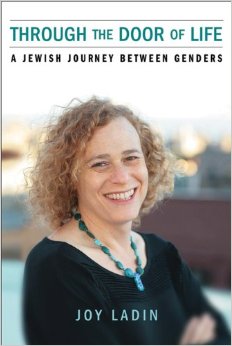 Through the Door of Life: A Jewish Journey between Genders
Through the Door of Life: A Jewish Journey between Genders
by Joy Ladin
Univ. of Wisconsin Press. 270 pages, $26.95
AUTHOR JOY LADIN “never much wanted to live.” Born into relative privilege, Ladin had a good childhood, but death always “seemed close.” Ladin remembers thinking that the idea of dying was exciting, while life was not, because he was forced to live in the wrong body, having been born as a boy. “I spent my childhood trying to be what people wanted me to be,” Ladin says, which worked outwardly. Few noticed or knew that he was struggling, so adept was he at tamping down feelings of sorrow.
At seventeen, while away at college, Ladin met his “life partner,” to whom he confessed his inner turmoil. The woman was undaunted. They married in 1982, but Ladin’s wife made it clear that she could accept Ladin’s transsexual feelings but not an actual transition. They started a family within the decade; Ladin took pride in being a father and tried to continue living the life of a heterosexual family man.
But in 2005, everything began to fall apart. Ladin started having panic attacks and suicidal thoughts. No longer able to withstand the soul-crushing pain of living in a body that was all wrong, he shaved off the beard that he’d had since puberty, began taking hormones, and attempted to make his wife understand his plight. For two years, he tried to maintain a dual life that would satisfy his wife, their three children, his God, and his colleagues at Stern College for Women of Yeshiva University. And slowly, Joy Ladin began to embrace the woman she knew herself to be.
Through the Door of Life is a bit of a conundrum. The book soars with a spirit of celebration, then drops like a stone into an abyss of angst. There are self-deprecating, humorous passages followed by wailing rants that almost hurt to read. There’s a little whining, though most of it is justifiable. And all this can happen in the space of a page or two. Unsurprisingly, much of this book is about Ladin’s family and how the transition affected and continues to define her relationships with three generations of relatives—a theme that’s revisited repeatedly throughout the book.
Though the subtitle of this book suggests a religious dimension to Ladin’s dilemma, there is curiously very little about her faith. There’s a bit of background on Orthodox Judaism, some light explanation as to why Ladin experienced such trepidation when coming out to her employer at Yeshiva, and a relatively short chapter of spiritual ruminations. The same basic sentiments are rehashed a number of times: that Orthodox Judaism strictly forbids men from wearing women’s clothing (and vice versa); that Ladin’s transition would shock many people; that it would probably herald the end of her academic career.
Given her high-profile academic position, Ladin’s transition was a major news story in Israel and even internationally. But behind the public story was a private struggle and learning experience, and Ladin pulls no punches in telling that story. She offers a peek into how daunting it was to learn, with little support from others, how to dress as a middle-aged woman, to put on make-up, to walk and talk like a female. She provides a front-row seat for observing how one person confronted a seemingly impossible situation and how she triumphed, however shakily, over the many adversities, both societal and psychological, that stood in the way.
________________________________________________________
Terri Schlichenmeyer is a frequent contributor based in Wisconsisn.





